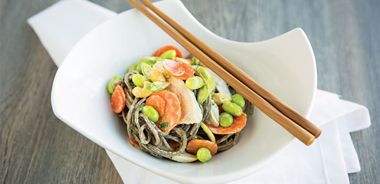Soba Noodles with Chicken and Curry Cashew Sauce

Nutty tasting soba noodles are bathed in a punchy cashew sauce that will surely make your lunch break a tastier affair. Don’t forget to pack the chopsticks. Poaching the chicken helps keep the meat moist. If you’re avoiding gluten, look for 100 percent buckwheat soba as some brands are also made with wheat. The noodle mixture can be served cold or warm, but should be kept chilled until lunchtime as it contains meat.
1/3 cup (80 mL) + 1/2 cup (125 mL) unsalted cashews
2/3 cup (160 mL) coconut milk
1 Tbsp (15 mL) yellow or green curry paste
1 Tbsp (15 mL) reduced sodium soy sauce
2 tsp (10 mL) grated fresh ginger
1 1/2 lbs (750 g) boneless, skinless organic chicken thighs
10 oz (280 g) soba noodles
1 1/2 cups (350 mL) frozen shelled edamame
3 medium-sized carrots, peeled and thinly sliced
2 green onions, thinly sliced
Place 1/3 cup (80 mL) cashews in bowl, cover with water, and let soak for at least 2 hours. Drain cashews and place in blender container along with coconut milk, curry paste, soy sauce, and ginger. Blend until smooth. Set aside.
Place chicken in large pot and add enough water to completely cover the thighs by at least 1 in (2.5 cm). Bring water to a very slight simmer with just a few bubbles breaking the surface, reduce heat to medium-low, partially cover, and cook for 15 minutes, or until meat is cooked through. Adjust heat as needed during cooking to maintain only the very light trembling of the water and skim off any foam that forms. Remove chicken with slotted spoon, and when cool enough to handle, thinly slice.
Meanwhile, prepare soba noodles according to package directions. Drain noodles in colander and rinse. Drain and rinse again. Drain thoroughly and then press down lightly on noodles to remove any excess liquid.
In medium-sized saucepan, prepare edamame according to package directions.
In large container, toss noodles with chicken, edamame, carrot, green onion, and remaining cashews. Add curry sauce and toss to coat.
Serves 7.
Each serving contains: 377 calories; 30 g protein; 19 g total fat (0 g sat. fat, 0 g trans fat); 20 g total carbohydrates (4 g sugars, 3 g fibre); 257 mg sodium
source: "The Lunch Bunch", alive #378, January 2015





